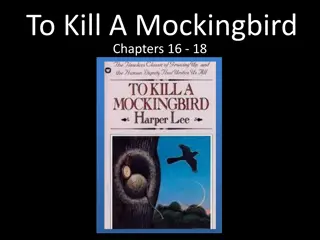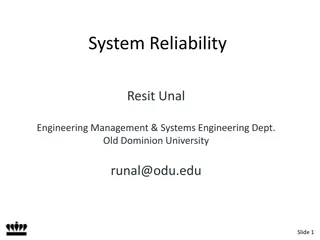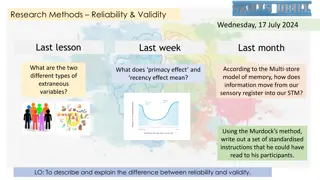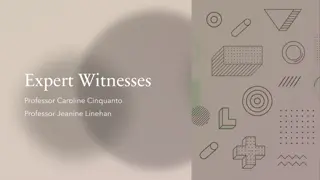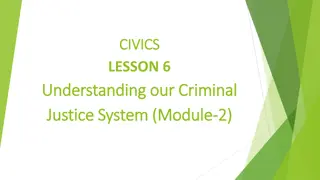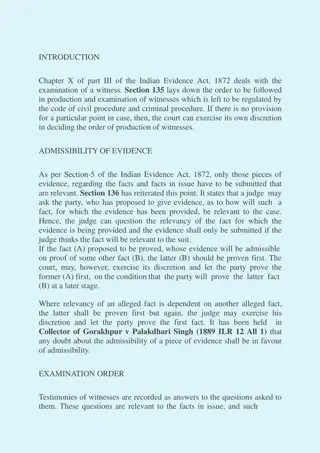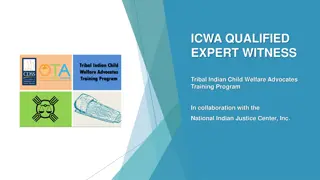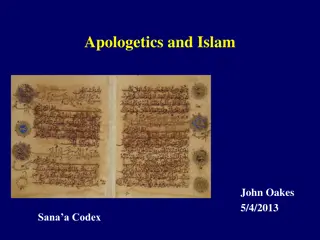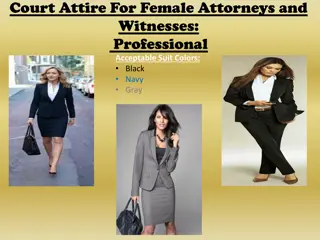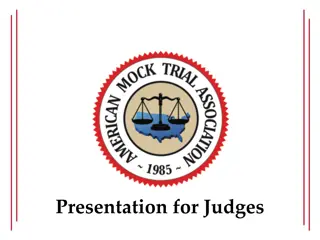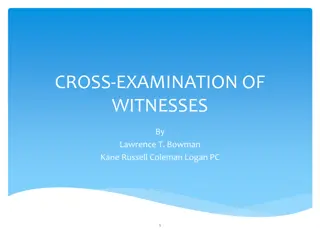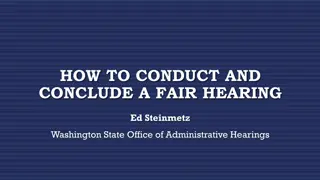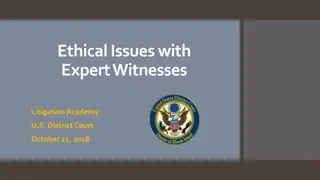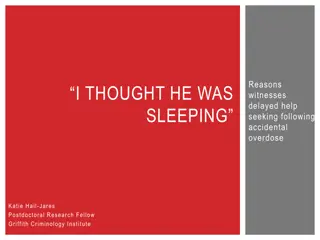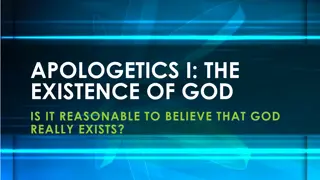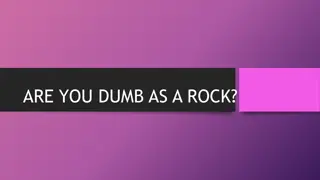Reliability of Witnesses & Apologetics Studies
Christian apologetics involves defending the faith with evidence and logic. It combines theology, natural theology, and philosophy to provide a rational basis for the Christian belief. The reliability of witnesses, as well as the witness of scripture, play crucial roles in this discipline. The study delves into the textual and historical reliability of the Bible, its internal consistency, relevance, and divine inspiration. Additionally, it examines the reliability of New Testament manuscripts, showcasing the abundance and accuracy of these ancient writings.
Download Presentation

Please find below an Image/Link to download the presentation.
The content on the website is provided AS IS for your information and personal use only. It may not be sold, licensed, or shared on other websites without obtaining consent from the author.If you encounter any issues during the download, it is possible that the publisher has removed the file from their server.
You are allowed to download the files provided on this website for personal or commercial use, subject to the condition that they are used lawfully. All files are the property of their respective owners.
The content on the website is provided AS IS for your information and personal use only. It may not be sold, licensed, or shared on other websites without obtaining consent from the author.
E N D
Presentation Transcript
The Reliability of Witnesses February 6, 2015 Ross Arnold, Winter 2015 Lakeside institute of Theology
Apologetics (CM4) Jan. 30 Introduction to Apologetics Feb. 6 Reliability of Witnesses Feb. 13 The Existence of God Feb. 20 The Existence of God 2 Feb. 27 Creation, Prophesy & Miracles Mar. 6 The Risen Christ Mar. 13 Responding to the Arguments Mar. 20 Applying the Principles; Final Exam
But in your hearts revere Christ as Lord. Always be prepared to give an answer to everyone who asks you to give the reason for the hope that you have. But do this with gentleness and respect, 16 keeping a clear conscience, so that those who speak maliciously against your good behavior in Christ may be ashamed of their slander. 1 Peter 3:15-17 The defense of the faith is not a luxury or intellectual vanity. It is a task appointed by God that you should be able to give a reason for the hope that is in you as you bear witness before the world. R. C Sproul
Apologetics (from Greek , "speaking in defense") is the discipline of defending a position (often religious) through the systematic use of information. Christian apologetics combines Christian theology, natural theology, and philosophy to present a rational basis for the Christian faith, to defend the faith against objections and misrepresentation, and to expose error within other religions and world views. Early Christian writers (c. 120 220) who defended their faith against critics and recommended their faith to outsiders were called Apologists.
The Witness of Scripture 1. Is the Bible textually reliable? Meaning does the Bible we have today accurately reflect the original Hebrew, Aramaic and Greek documents? Is there any evidence the Bible is inaccurate? 2. Is the Bible historically reliable? Is there evidence that Scripture accurately reflects real events in the past? 3. Is the Bible internally consistent? Or is it full of contradictions, as is often claimed? 4. Is the Bible relevant? Does it have a history of being meaningful in the lives of real people in real situations? 5. Ultimately, is there support for the idea that the Bible is more than just a human document, but instead is truly the Word of God?
Reliability of New Testament Manuscripts There are 5,686 Greek New Testament manuscripts in existence today. Compared to other ancient writings, the New Testament manuscripts far outweigh others in quantity and accuracy. 18 NT manuscripts are from the 2nd century, and one from the 1st Century. Author Date Written Copy Pliny 61-113 A.D. 850 A.D. Plato 427-347 B.C. 900 A.D. Demosthenes 4th Cent. B.C. 1100 A.D. Thucydides 460-400 B.C. 900 A.D. Euripides 480-406 B.C. 1100 A.D. Aristophanes 450-385 B.C. 900 A.D. Caesar 100-44 B.C. 900 A.D. Tacitus circa 100 A.D. 1100 A.D. Aristotle 384-322 B.C. 1100 A.D. Sophocles 496-406 B.C. 1000 A.D. Homer (Iliad) 900 B.C. 400 B.C. New Testament (49-100 A.D.) Earliest Time Gap to Copy 750 yrs # of Copies 7 Accuracy of Copies ---- 1200 yrs 800 yrs 7 8 ---- ---- 1300 yrs 8 ---- 1300 yrs 9 ---- 1200 1000 10 10 ---- ---- 1000 yrs 20 ---- 1400 49 ---- 1400 yrs 500 yrs 193 643 ---- 95% 1st Cent. A.D. c. 130 A.D. < 100 years 5686 99.5%
The basic problem: "We have no autograph manuscripts of the Greek and Roman classical writers and no copies which have been collated with the originals; the manuscripts we possess derive from the originals through an unknown number of intermediate copies, and are consequently of questionable trustworthiness. The business of textual criticism is to produce a text as close as possible to the original (constitutio textus). Paul Mass The textual critic's ultimate objective is the production of a "critical edition closely approximating the original. The textual critic's ultimate objective is the production of a "critical edition a text most closely approximating the original. a text most
The Nature of Textual Errors in Scripture Unintentional Errors (95% of textual variants) 1. Errors of Sight. Scribes sometimes copied texts by looking back and forth to the originals. By this method, they inevitably made a number of errors of sight. 2. Errors of Hearing. When scribes copied manuscripts through dictation (that is, scribes wrote as a manuscript was being read), errors of hearing were made. 3. Errors of Writing. Sometimes scribes introduced errors into texts simply by writing the wrong thing. 4. Errors of Judgment. Sometimes scribes exercised poor judgment through incorporating marginal glosses (ancient footnotes) into the body of the text or similar unintentional corrupting influences.
The Nature of Textual Errors in Scripture Intentional Errors (5% of textual variants) 1. Revising Grammar and Spelling. 2. Harmonizing Similar Passages. Scribes tended to harmonize parallel passages and introduce uniformity to stylized expressions. 3. Eliminating Apparent Discrepancies and Difficulties. Scribes sometimes fixed what they perceived as problems in the text. 4. Conflating the Text. Sometimes scribes combined variant readings when copying, conflating them together. 5. Adapting Different Liturgical Traditions. It is possible that church liturgy (i.e., stylized prayers or praises) influenced some textual additions or wording changes. 6. Making Theological or Doctrinal Changes. Sometimes scribes made theological or doctrinal changes omitting or clarifying something they saw as wrong.
Is the Bible historically reliable? Archaeology No archeological discovery has ever controverted [overturned] a Biblical reference. Scores of archeological findings have been made which confirm in clear outline or in exact detail historical statements in the Bible. And, by the same token, proper evaluation of Biblical descriptions has often led to amazing discoveries. Nelson Glueck, Hittites Jericho City names/locations King David Pontius Pilate etc., etc
Is the Bible internally consistent? Are there contradictions in the Bible? How many angels at the tomb? (Matt. 28 v. John 20) Was Jesus a carpenter? (Mark 6 v. Matt. 13) What time was Jesus crucified? (Mark 15 v. John 19) Many supposed contradictions are instead complementary simply offering a different emphasis and perspective on the same basic event, without either being wrong or untrue. If the Gospels said the same thing in the same way, they would be discredited on grounds that they secretly harmonize their writings to deceive people.
The Bible is by far the most published, most read, most translated, most influential and most cherished book in history. 2,530 languages; 531 with the complete text of the Bible;1,715 with complete Old or New Testaments, including 55 sign languages. "Pile them (Eastern holy books), if you will, on the left side of your study table; but place your own Holy Bible on the right side all by itself, all alone and with a wide gap between them. For , . . . there is a gulf between it and the so-called sacred books of the East which severs the one from the other utterly, hopelessly, and forever... a veritable gulf which cannot be bridged over by any science of religious thought. Professor M. Montiero-Williams
The Bible has withstood vicious attacks of its enemies as no other book. Many have tried to burn it, ban it and outlaw it. "No other book has been so chopped, knived, sifted, scrutinized, and villified. What book on philosophy or religion or psychology or belles lettres of classical or modern times has been subject to such a mass attack as the Bible? with such venom and skepticism? with such thoroughness and erudition? upon every chapter, line and tenet? "The Bible is still loved by millions, read by millions, and studied by millions. Bernard Ramm









